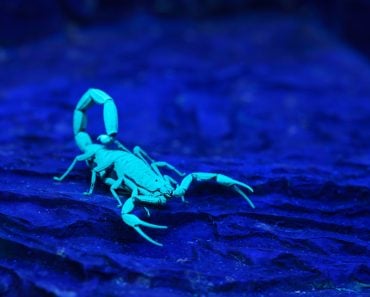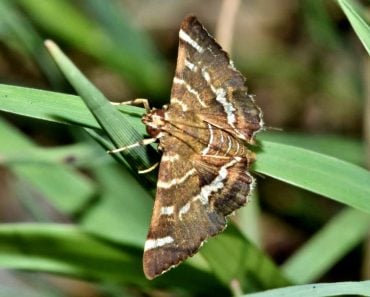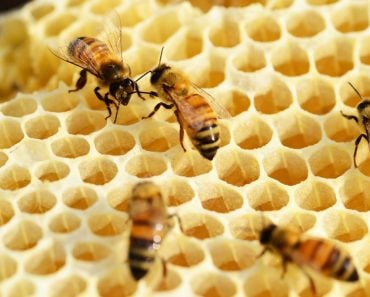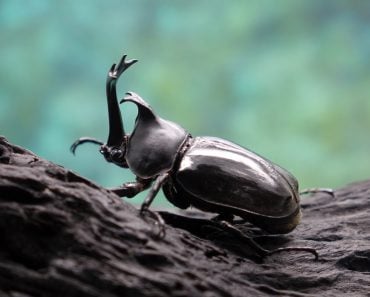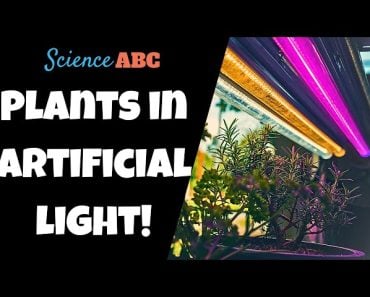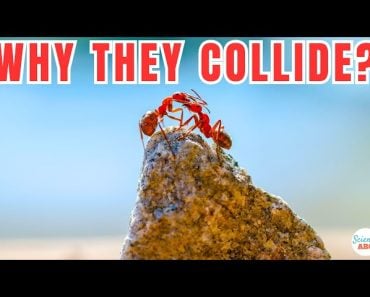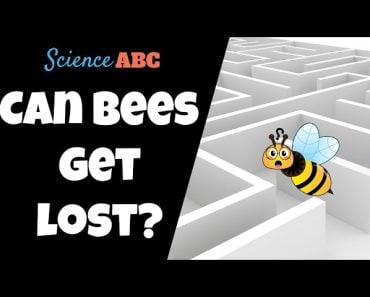Recent research suggests that artificial lights interfere with insects’ sense of spatial orientation. This refutes the popular hypothesis that insects confuse the lights for celestial navigational cues.
The phrase, “Drawn like a moth to a flame,” derives from the habit of moths (and most other bugs) to fly towards any source of light. We’ve all seen insects cluster around brightly lit street lamps at night and wondered what they find so attractive about the light.
Bright bug zappers lure insects into their glow and then kill the poor pests.
This phenomenon is well known, but scientists can only offer their best guesses as to why it happens. There was little experimental research to back up popular claims, and it seemed this behavior would remain a mystery…
…until now!
In January 2024, researchers from the UK, America, and Costa Rica published a groundbreaking study in Nature about why insects are lured in and trapped by light sources. They challenge popular hypotheses about the phenomenon and suggest something altogether new.
Recommended Video for you:
Hypotheses Of Why Insects Fly To The Light
Light is important for almost all forms of life. It dictates when you’re awake or asleep, whether you can make food (plants), and even give you nutrients (vitamin D).
For insects, light dictates several of their behaviors. Scientists use these behaviors to explain the insect’s seemingly illogical behavior.
One hypothesis suggests that insects fly towards the light as an escape mechanism, similar to how they would fly toward a bright spot from between a thicket of leaves. A second hypothesis suggested that heat from the light attracted the insects, rather than the light itself.
However, the most popular hypothesis was that the insects mistake the light for the moon.
Just as we use the North Star as a navigational guide, many nocturnal insects use celestial objects, such as the moon, stars, and the Milky Way as a compass to help navigate in the dead of the night. Scientists have proposed that artificial lights, being brighter than celestial objects, confused their navigational systems and caused them to hover around the light.
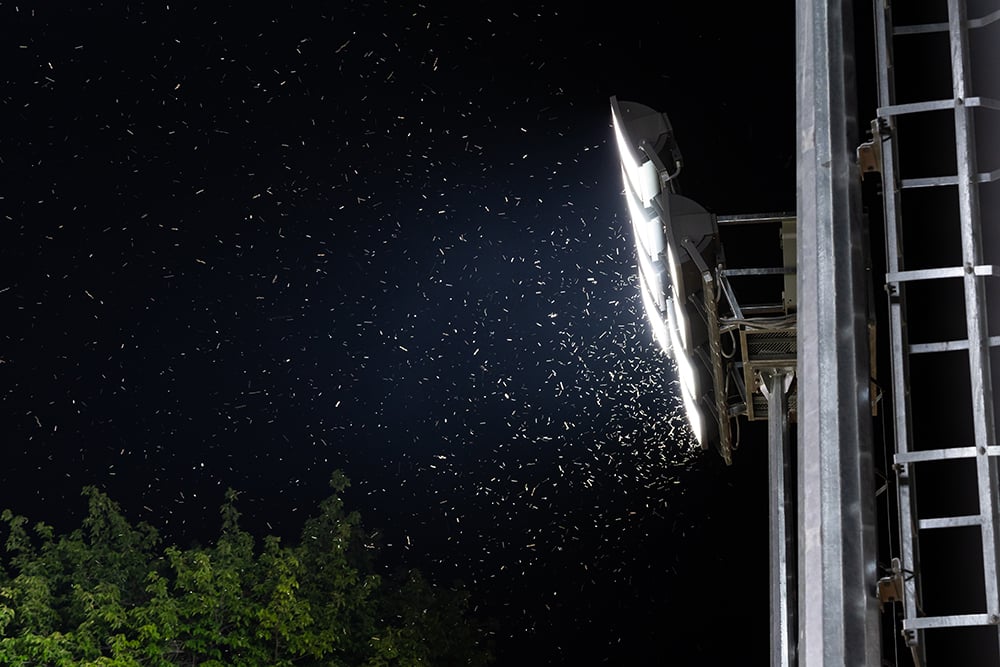
Most of these explanations have little data to support them.
To study the insect’s behavior, researchers Samuel T. Fabian from Imperial College London and Yash Sondhi from Florida International University, along with their colleagues from the Council on International Educational Exchange in Costa Rica and Florida International University, used the latest camera technology to track the insect’s flight paths and create a 3D model of their movement.
The data they collected surprised even the researchers. It indicated that all the above hypotheses were incorrect. As the insects flew around the light, their flight paths revealed unexpected behaviors.
Insects Use Light To Orient Themselves In Space
Imagine you’re a tiny flying insect. You can fly with your delicate yet powerful wings, as gravity is less troublesome for you than it is for an elephant. However, along with being small and (relatively) light comes the trouble of knowing your orientation in space. Along with gravity, these insects use visual cues to determine which way is “up”.
For most of Earth’s history, the sky has been brighter than any object on the planet, which makes it a reliable cue for where “up” is. Insects and many other animals orient their back or dorsal sides to the sky as they fly around. This behavior is called dorsal light response.
The researchers tracked the flight of 30 insects from four different species: the Common Darter (Sympetrum striolatum), the Migrant Hawker (Aeshna mixta) dragonflies, the Large Yellow Underwing (Noctua pronuba), and Lorquin’s Atlas Moth (Attacus lorquinii).
The insects showed three distinct flight behaviors: they orbited around the light, they flew upwards and over the light in a steep climb (called stalling), and they inverted over the light as they dived downwards. During each behavior, the insects kept their backs to the light.
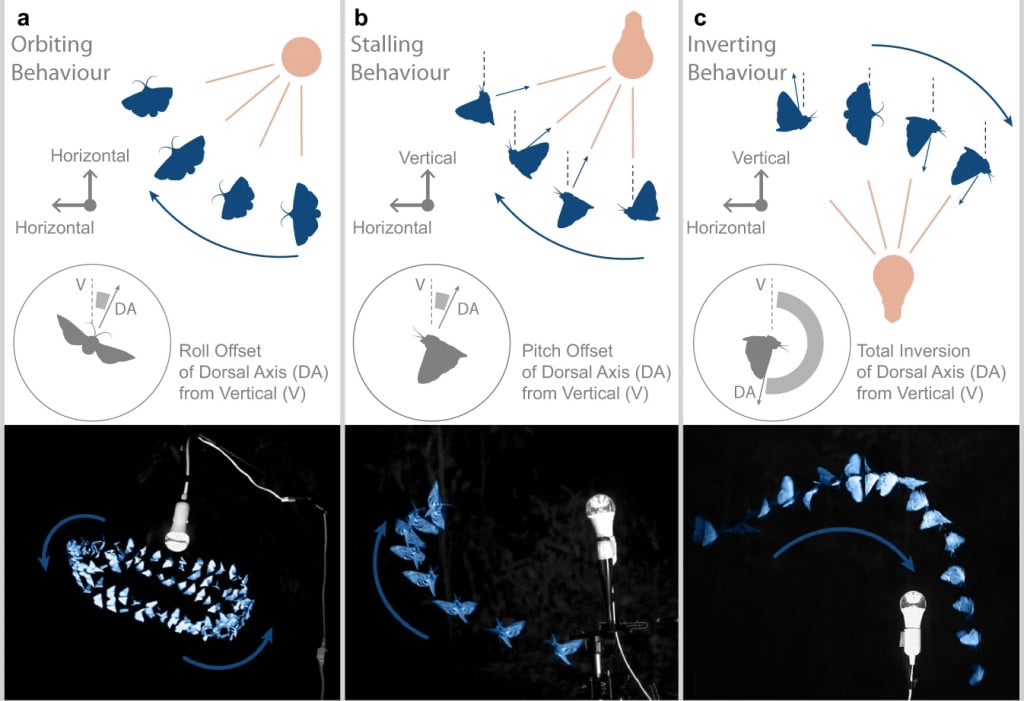
The researchers also carried out a second set of experiments to confirm their findings.
They set up diffuse lighting conditions by reflecting light either downward or upwards onto a white sheet. When exposed to the downward-facing lights, the insects flew up to the light and then dove down towards the reflected portion. However, the insects maintained a relatively stable path forward when the lights were reflected upwards on the white canopy.
Insects moving upwards with upward-facing light and crashing with downward-facing light (Credits: Fabian, S.T., Sondhi, Y., Allen, P.E. et al. Why flying insects gather at artificial light. Nat Commun 15, 689 (2024). https://doi.org/10.1038/s41467-024-44785-3)
They performed the second set of experiments with bees and flies—insects that were too small for motion capture—and found similar results.
Some Debunked Myths Related To Insects Flying Towards The Light
But what about the other hypothesis? Can we rule that out completely or might they also explain the behavior?
The flight patterns from the study say no.
The escape response can’t explain the behavior because instead of flying straight towards the light, the insects flew at right angles to it.
The heat source explanation fails since the researchers found the insects drawn to LED lights, which emit very little heat.
Lastly, the popular celestial navigation hypothesis also fails. For the celestial navigation hypothesis to work, the insects should keep the light as a constant source in their visual field. The insects would have to spiral around the light while facing the light, but the researchers did not observe this.
Proposing Better Lighting For Insects
The paper provides the first concrete explanation for why insects are attracted to artificial light, but there are plenty of unanswered questions.
Oleander Hawkmoths and vinegar flies were less affected by the artificial lights than the other insects. These insects must use a combination of senses to tell which way is up.
Their work might prove important for cities. In the past few years, artificial lighting and light pollution have become major concerns for ecologists. Evidence shows that artificial lights in cities can disrupt insect behavior and populations, most notably in moths, the poster child for this phenomenon.
This new evidence could lead to better recommendations for lighting in cities. “Reducing bright, unshielded, and upward-facing lights will mitigate the impact on flying insects at night,” noted the researchers.
References (click to expand)
- Fabian, S. T., Sondhi, Y., Allen, P. E., Theobald, J. C., & Lin, H.-T. (2024, January 30). Why flying insects gather at artificial light. Nature Communications. Springer Science and Business Media LLC.
- Goulard, R., Verbe, A., Vercher, J.-L., & Viollet, S. (2018, May). Role of the light source position in freely falling hoverflies' stabilization performances. Biology Letters. The Royal Society.
- Degen, J., Storms, M., Lee, C. B., Jechow, A., Stöckl, A. L., Hölker, F., … Degen, T. (2022, October 8). Streetlights affect moth orientation beyond flight-to-light behaviour. []. Cold Spring Harbor Laboratory.


